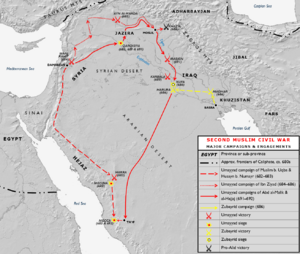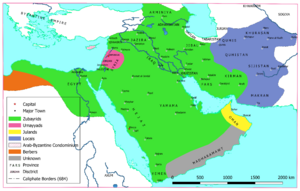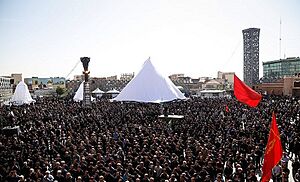Second Fitna facts for kids
Quick facts for kids Second Fitna |
|||||||||
|---|---|---|---|---|---|---|---|---|---|
| Part of the Fitnas | |||||||||
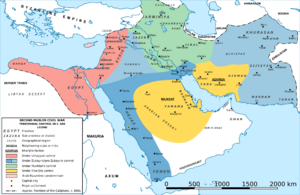 Territorial control by the contenders to the caliphate during the peak of the civil war (686) |
|||||||||
|
|||||||||
| Belligerents | |||||||||
| Umayyad Caliphate | Zubayrid Caliphate | Alids | Kharijites | ||||||
| Commanders and leaders | |||||||||
| Yazid I Muslim ibn Uqba Umar ibn Sa'ad (686) † Marwan I Abd al-Malik Ubayd Allah ibn Ziyad (686) † Husayn ibn Numayr (686) † Hajjaj ibn Yusuf |
Abd Allah ibn al-Zubayr (692) † Mus'ab ibn al-Zubayr (691) † Ibrahim ibn al-Ashtar (691) † Muhallab ibn Abi Sufra (Defected) |
Husayn ibn Ali (680) † Sulayman ibn Surad (685) † Mukhtar al-Thaqafi (687) † Ibrahim ibn al-Ashtar (Defected) |
Nafi ibn al-Azraq (685) † Najda ibn Amir al-Hanafi (691/92) † |
||||||
The Second Fitna was a major civil war in the early Umayyad Caliphate, a large Islamic empire. It was a time of great political and military trouble. This conflict started in 680, after the death of the first Umayyad leader, Mu'awiya I. It lasted for about twelve years.
The war involved two main groups challenging the Umayyad dynasty. One group supported Husayn ibn Ali, a grandson of the Islamic prophet Muhammad. His followers, like Sulayman ibn Surad and Mukhtar al-Thaqafi, sought to avenge his death in Iraq. The other main challenger was Abd Allah ibn al-Zubayr, who wanted to be the caliph (leader of the Muslim community).
The problems that led to this war began with the First Fitna, an earlier civil war. After the third caliph, Uthman, was killed in 656, the Muslim community faced a crisis over who should lead. Ali, Muhammad's cousin and son-in-law, and Mu'awiya were the main rivals. Mu'awiya became the sole ruler after Ali's death in 661.
Mu'awiya's decision to name his son Yazid as his heir was new and caused a lot of disagreement. When Mu'awiya died, tensions grew. Husayn ibn Ali was invited by supporters in Kufa to challenge the Umayyads. However, he was killed with his small group at the Battle of Karbala in October 680.
Yazid's army later attacked rebels in Medina in August 683. Then, they surrounded Mecca, where Ibn al-Zubayr had declared himself caliph. When Yazid died in November 683, the siege of Mecca ended. Umayyad power weakened everywhere except in parts of Syria. Most areas then recognized Ibn al-Zubayr as the new caliph.
Several movements arose in Kufa, demanding justice for Husayn's death. One was the "Penitents movement" led by Ibn Surad, but the Umayyads defeated them in January 685. Kufa was then taken over by Mukhtar. His forces won a big battle against an Umayyad army in August 686. However, Mukhtar and his supporters were later defeated and killed by Ibn al-Zubayr's forces in April 687.
Under the leadership of Abd al-Malik ibn Marwan, the Umayyads regained control. They defeated Ibn al-Zubayr's forces in Iraq and killed Ibn al-Zubayr during the siege of Mecca in 692. Abd al-Malik then made important changes to the caliphate's government. The events of the Second Fitna also led to stronger differences between the groups that would become Sunni and Shi'a Muslims.
Contents
How the Conflict Began
After the third caliph Uthman was killed in 656, rebels and people in Medina chose Ali as the new caliph. Ali was a cousin and son-in-law of the Islamic prophet Muhammad. However, many powerful families from Mecca, including Muhammad's companions Talha ibn Ubayd Allah and Zubayr ibn al-Awwam, and Muhammad's widow A'isha, did not accept Ali. They wanted justice for Uthman's death and a new caliph chosen by discussion. This led to the First Fitna.
Ali won against these opponents in the Battle of the Camel in November 656. He then moved his capital to Kufa in Iraq. Mu'awiya, the governor of Syria and a member of the Umayyad family, also refused to accept Ali as caliph. They fought at the Battle of Siffin. The battle ended in a draw when Ali's soldiers agreed to talks.
A group of Ali's soldiers, later called the Kharijites, left his side. They believed accepting talks was wrong. Ali was later killed by a Kharijite in January 661. Ali's eldest son, Hasan, became caliph, but Mu'awiya challenged him. In August, Hasan gave up his claim to Mu'awiya in a peace treaty. This ended the First Fitna, and the capital moved to Damascus.
Yazid Becomes Caliph
The peace treaty brought a temporary calm, but it didn't set up a clear way for the next leader to be chosen. Mu'awiya wanted to solve this problem during his lifetime. In 676, he announced that his son Yazid would be the next caliph. This was new in Islamic history, as leaders were usually chosen, not inherited. Many people saw this as turning the caliphate into a kingdom.
Mu'awiya held a meeting in Damascus and convinced leaders from different areas to accept Yazid. Some important figures, like Husayn ibn Ali and Abd Allah ibn al-Zubayr, opposed this. They felt they also had a right to be caliph. Mu'awiya's threats and the general acceptance of Yazid made them stay quiet for a while.
When Mu'awiya died in April 680, the disagreements over leadership quickly returned. Before he died, Mu'awiya warned Yazid that Husayn and Ibn al-Zubayr might challenge him. Yazid told his governor in Medina to get loyalty from Husayn and Ibn al-Zubayr, using force if needed. Ibn al-Zubayr escaped to Mecca. Husayn met with the governor but refused to give his loyalty in secret. A few days later, Husayn also left for Mecca without accepting Yazid.
Challenges to Yazid's Rule
Husayn ibn Ali's Revolt
Husayn had strong support in Kufa. The people there had fought the Umayyads before and disliked their rule. After Mu'awiya died, Husayn's supporters in Kufa invited him to lead a revolt against Yazid. Husayn sent his cousin, Muslim ibn Aqil, to check the situation. Ibn Aqil found strong support and told Husayn to come.
Yazid replaced the Kufa governor who wasn't stopping Ibn Aqil. The new governor, Ubayd Allah ibn Ziyad, quickly stopped the rebellion and killed Ibn Aqil. Husayn, unaware of this, left for Kufa. Ibn Ziyad sent troops to block the roads. Husayn was stopped at Karbala, a desert plain north of Kufa. About 4,000 soldiers arrived to force him to surrender. After a few days of talks, Husayn refused to give in. He was killed along with about 70 male companions in the Battle of Karbala on October 10, 680.
Opposition in Mecca and Medina
After Husayn's death, Yazid faced more opposition from Abd Allah ibn al-Zubayr. Ibn al-Zubayr was the son of Muhammad's companion Zubayr ibn al-Awwam. He secretly began gaining support in Mecca, though he publicly called for a meeting to choose a new caliph. Yazid tried to calm him with gifts, but Ibn al-Zubayr refused to accept him.
Yazid then sent an army to arrest Ibn al-Zubayr, but they were defeated. In Medina, people were also unhappy with Umayyad rule. They disliked how Mu'awiya had taken their lands for farming. Yazid invited leaders from Medina to Damascus and offered them gifts. But they were not convinced. They returned to Medina telling stories of Yazid's lavish lifestyle and actions they saw as un-Islamic.
The people of Medina, led by Abd Allah ibn Hanzala, rejected Yazid's rule. They forced out the governor and other Umayyads in the city. Yazid sent a large army of 12,000 soldiers to take back the Hejaz (western Arabia). After talks failed, the Medinese were defeated in the Battle of al-Harra. The city was then plundered for three days. After forcing the rebels to accept his rule again, Yazid's army marched to Mecca to defeat Ibn al-Zubayr.
The army commander died on the way, and Husayn ibn Numayr took command. He surrounded Mecca in September 683. The siege lasted several weeks, and the Ka'aba, a holy building, caught fire. Yazid's sudden death in November ended the campaign. Ibn Numayr tried to convince Ibn al-Zubayr to come to Syria and be declared caliph there, but he refused. So, Ibn Numayr left with his troops.
Ibn al-Zubayr's Claim to Power
With Yazid's death and the Syrian army's departure, Ibn al-Zubayr became the ruler of the Hejaz and the rest of Arabia. He openly declared himself caliph. Soon, Egypt and Iraq recognized him too. Coins with Ibn al-Zubayr's name were even made in parts of Persia.
Struggle for Syria
After Yazid's death, his son Mu'awiya II became caliph, but his power was limited to parts of Syria. Mu'awiya II died after a few months, and there was no clear Umayyad heir. Some tribes in northern Syria supported Ibn al-Zubayr. Many Umayyads, including Marwan ibn al-Hakam, were also willing to accept him.
However, pro-Umayyad tribes, especially the Banu Kalb, were strong in Jordan and Damascus. They wanted an Umayyad leader. A Kalbite chief convinced Marwan to become caliph. Marwan was accepted as caliph in a meeting of pro-Umayyad tribes in June 684. Tribes supporting Ibn al-Zubayr refused to recognize Marwan. The two sides fought at the Battle of Marj Rahit in August. The pro-Zubayrid tribes were heavily defeated.
Marwan becoming caliph was a turning point. Syria was reunited under the Umayyads, and they began to regain lost lands. Marwan and his son took Egypt from Ibn al-Zubayr's governor. An Umayyad attempt to retake the Hejaz was defeated near Medina. Marwan sent Ibn Ziyad to restore Umayyad control in Iraq. After Marwan died in April 685, his son Abd al-Malik became caliph.
Pro-Alid Movements
The Tawwabin Uprising
Some important supporters of Ali in Kufa felt guilty for not helping Husayn. They started a movement to fight the Umayyads, led by Sulayman ibn Surad. They called themselves the "Tawwabin" (Penitents), meaning those who seek forgiveness. They stayed hidden while the Umayyads controlled Iraq.
After Yazid's death, the Tawwabin openly called for revenge for Husayn's killing. They gained a lot of support in Kufa. However, they didn't have a clear political plan, only wanting to punish the Umayyads or die trying. When Mukhtar returned to Kufa, he tried to convince the Tawwabin to join his more organized movement. But Ibn Surad's influence kept his followers from accepting Mukhtar's idea.
In November 684, the Tawwabin marched to fight the Umayyads. The two armies met in January 685 at the Battle of Ayn al-Warda in Upper Mesopotamia. The battle lasted three days, and most of the Tawwabin, including Ibn Surad, were killed. A few escaped back to Kufa.
Mukhtar al-Thaqafi's Revolt
Since returning to Kufa, Mukhtar had been calling for revenge for Husayn's killers. He also wanted to establish a caliphate under Ali's son, Muhammad ibn al-Hanafiyya, saying he was his representative. The defeat of the Tawwabin left Mukhtar as the main leader of the pro-Ali supporters in Kufa.
In October 685, Mukhtar and his followers took control of Kufa. Many of his supporters were local, non-Arab converts to Islam called mawali. Mukhtar treated the mawali equally with the Arabs, which upset the Arab tribal leaders. After putting down a rebellion by these Arab leaders, Mukhtar executed Kufans who were involved in Husayn's killing. This caused thousands of Kufan nobles to flee to Basra.
Mukhtar then sent his general, Ibrahim ibn al-Ashtar, to fight an Umayyad army led by Ibn Ziyad. This army was sent to retake the province. The Umayyad army was defeated at the Battle of Khazir in August 686, and Ibn Ziyad was killed. In Basra, Kufan refugees convinced Mus'ab ibn al-Zubayr, Abd Allah ibn al-Zubayr's younger brother, to attack Kufa.
Mukhtar sent his army to fight Mus'ab, but they were defeated in the first battle. Mukhtar's army retreated but was destroyed by Mus'ab's forces in a second battle. Mukhtar and his remaining supporters hid in Kufa's palace. Mus'ab's forces surrounded them. Four months later, in April 687, Mukhtar was killed while trying to fight his way out. About 6,000 of his supporters surrendered and were executed. Mukhtar's fall left the Umayyads and the Zubayrids as the main groups fighting.
Umayyad Victory
After Marwan became caliph in June 684, Ibn Ziyad was sent to retake Iraq. He defeated the Tawwabin at Ayn al-Warda. After their defeat at Marj Rahit, the Qays tribes had regrouped in Jazira and stopped Ibn Ziyad from retaking the province for a year. They continued to support Ibn al-Zubayr.
Ibn Ziyad then captured Mosul from Mukhtar's governor. Mukhtar sent a small army to retake the city. Despite winning the battle in July 686, Mukhtar's forces retreated because the Syrians had more soldiers. A month later, Ibn Ziyad was killed by Mukhtar's army at the Battle of Khazir. With Ibn Ziyad dead, Abd al-Malik stopped his plans to retake Iraq for several years. He focused on strengthening his rule in Syria, which faced its own problems.
After making peace with the Byzantines and dealing with internal issues, Abd al-Malik turned his attention back to Iraq. In 691, he surrounded the Qaysite stronghold in Jazira. When he couldn't defeat them, he won over the Qays with promises of forgiveness. With these new allies, he moved to defeat Mus'ab.
Mus'ab's position in Iraq had weakened. The Kharijites had started raiding again in Arabia, Iraq, and Persia. In eastern Iraq and Persia, a Kharijite group had taken Fars and Kirman from the Zubayrids in 685. The people of Kufa and Basra also turned against Mus'ab because of his harsh actions against Mukhtar's supporters. As a result, many of Ibn al-Zubayr's loyalists switched sides to Abd al-Malik.
Mus'ab was unable to fight Abd al-Malik effectively. Many of his soldiers and his best commander were away guarding Basra from the Kharijites. Mus'ab was defeated and killed at the Battle of Maskin in October 691.
Having secured Iraq, Abd al-Malik sent his general Hajjaj ibn Yusuf against Abd Allah ibn al-Zubayr. Ibn al-Zubayr was cornered in the Hejaz by another Kharijite group. Hajjaj set up base in Ta'if and won several small battles against Ibn al-Zubayr's forces. Syrian soldiers captured Medina and then joined Hajjaj. Hajjaj surrounded Mecca in March 692.
The siege lasted six to seven months. Most of Ibn al-Zubayr's forces surrendered. He was killed fighting with his remaining supporters in October/November. With his death, the Hejaz came under Umayyad control, ending the civil war. Soon after, the Kharijites were defeated.
What Happened Next
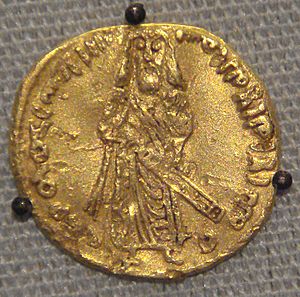
With Abd al-Malik's victory, Umayyad power was restored, and the idea of rulers inheriting their position became stronger. Abd al-Malik and his family ruled for another fifty-eight years. They were eventually overthrown by the Abbasid Revolution in 750.
Changes in Government
After winning the war, Abd al-Malik made big changes to how the caliphate was run. Before him, Mu'awiya had ruled through personal connections. He had a trained Syrian army, but it was mostly used for fighting the Byzantines. At home, he used diplomacy. Local leaders, not government officials, were the link between governors and the public. Military units in the provinces were made of local tribes, also led by local chiefs.
Provinces kept most of their tax money and sent only a small part to the caliph. The old government systems of the conquered lands stayed the same. Officials who had worked for the Persian or Byzantine empires kept their jobs. Local languages were still used officially, and Byzantine and Persian coins were still used.
During the civil war, many local leaders had switched their support to Ibn al-Zubayr. This convinced Abd al-Malik that Mu'awiya's system, where power was spread out, was hard to control. So, he decided to centralize his power. He created a professional army in Syria to enforce government authority in all provinces. Also, important government jobs were given to the caliph's close relatives.
Abd al-Malik made governors send all extra money from their provinces to the capital. He also made Arabic the official language for government work. A single Islamic currency replaced the old Byzantine and Persian coins. This gave the Umayyad government a more Muslim identity. He also stopped giving permanent payments to those who fought in early Muslim conquests and set up fixed salaries for active soldiers. Abd al-Malik's way of governing was copied by many Muslim governments that came after him.
Tribal Divisions
During this period, especially after the Battle of Marj Rahit, deep divisions grew between Arab tribes. These divisions led to two main groups across the caliphate: the "North Arab" group and the "South Arab" or Yemeni group. These names were more about politics than geography.
The Umayyad caliphs tried to keep a balance between these two groups. But their constant fight for power caused problems in the provinces. This tribal rivalry helped cause the Third Fitna and contributed to the Umayyads' eventual downfall. These divisions lasted for a very long time. Even in the 1800s, groups in Palestine were still fighting, calling themselves Qays and Yaman.
Religious Changes
Husayn's death caused a lot of sadness and anger. It helped turn the opposition to Yazid into a strong anti-Umayyad movement based on supporting Ali's family. The Battle of Karbala led to a clear split between what later became the Shi'a and Sunni branches of Islam. This event changed Shi'ism from just a political stance into a religious movement. To this day, Shi'a Muslims remember it every year on the Day of Ashura.
This time also saw the end of purely Arab Shi'ism with Mukhtar al-Thaqafi's revolt. He brought together non-Arab Muslims, called mawali, who had been treated unfairly. Before this, non-Arab Muslims hadn't played a big role in politics. Even though Mukhtar's movement failed politically, his ideas lived on through a group called the Kaysanites. This group introduced new religious ideas that influenced how Shi'ism developed later.
The Second Fitna also led to the idea of the Islamic Messiah, called the Mahdi. Mukhtar used the title Mahdi for Ali's son, Muhammad ibn al-Hanafiyya. While "Mahdi" had been used as an honorable title before, Mukhtar used it to mean a divinely guided ruler who would fix Islam.
Many people saw Ibn al-Zubayr's rebellion as an attempt to return to the pure values of the early Muslim community. His revolt was welcomed by many who were unhappy with Umayyad rule. For them, Ibn al-Zubayr's defeat meant that all hope of bringing back the old ideals of Islamic government was lost. In this atmosphere, Ibn al-Zubayr's role as an anti-caliph shaped the later idea of the Mahdi. Some parts of his story became part of hadiths (sayings attributed to Muhammad) about the Mahdi. These included the Mahdi escaping from Medina to Mecca, taking refuge in the Ka'aba, and defeating an army sent against him. These ideas then became features of the Mahdi who would appear in the future to restore Islam's past glory. This idea later became an important belief in Islam.
|


